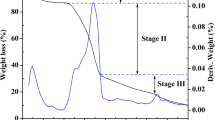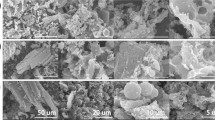Abstract
Porous carbon adsorbents were prepared from microalgae (Chlorococcum sp.) via directly hydrothermal carbonization coupled with KOH or NH3 activation for Cr(VI) adsorption. KOH-activated porous carbons exhibit high Cr(VI) adsorption capacities than those obtained via NH3 modification (370.37 > 95.70 mg/g). The superior Cr(VI) adsorption capacity is due to high surface areas (1784 m2/g) and pore volumes of porous carbon with mesoporous and macroporous structures. The Cr(VI) adsorption result was well fitted to the Langmuir model, showing that the removal of Cr(VI) was attributed to the monolayer adsorption of activity site on carbon surface.



Similar content being viewed by others
References
Minami, E., & Saka, S. (2005). Biomass resources present in Japan—annual quantities grown, unused and wasted. Biomass and Bioenergy, 29(5), 310–320.
Gupta, R. B., & Demirbas, A. (2010). Gasoline, diesel and ethanol biofuels from grasses and plants. Cambridge: Cambridge University Press.
Azar, C., Lindgren, K., Larson, E., & Möllersten, K. (2006). Carbon capture and storage from fossil fuels and biomass—costs and potential role in stabilizing the atmosphere. Climatic Change, 74(1-3), 47–79.
Sevilla, M., Macia-Agullo, J. A., & Fuertes, A. B. (2011). Hydrothermal carbonization of biomass as a route for the sequestration of CO2: chemical and structural properties of the carbonized products. Biomass & Bioenergy, 35(7), 3152–3159.
Liu, W. J., Zeng, F. X., Jiang, H., & Zhang, X. S. (2011). Preparation of high adsorption capacity bio-chars from waste biomass. Bioresource Technology, 102(17), 8247–8252.
Libra, J. A., Ro, K. S., & Kammann, C. (2011). Hydrothermal carbonization of biomass residuals: a comparative review of the chemistry, processes and applications of wet and dry pyrolysis. Biofuels, 2(1), 89–124.
Sevilla, M., & Fuertes, A. B. (2009). Chemical and structural properties of carbonaceous products obtained by hydrothermal carbonization of saccharides. Chemistry, 15(16), 4195–4203.
Sevilla, M., & Fuertes, A. B. (2009). The production of carbon materials by hydrothermal carbonization of cellulose. Carbon, 47(9), 2281–2289.
Titirici, M. M., Thomas, A., & Antonietti, M. (2007). Back in the black: hydrothermal carbonization of plant material as an efficient chemical process to treat the CO2 problem? New Journal of Chemistry, 31(6), 787–788.
Kumar, S., Loganathan, V. A., Gupta, R. B., & Barnett, M. O. (2011). An assessment of U(VI) removal from groundwater using biochar produced from hydrothermal carbonization. Journal of Environment Management, 92(10), 2504–2512.
Liu, Z. G., & Zhang, F. S. (2009). Removal of lead from water using biochars prepared from hydrothermal liquefaction of biomass. Journal of Hazardous Materials, 167(1–3), 933–939.
Liu, Z. G., & Zhang, F. S. (2011). Removal of copper (II) and phenol from aqueous solution using porous carbons derived from hydrothermal chars. Desalination, 267(1), 101–106.
Kumar, S., Kothari, U., Lee, Y. Y., & Gupta, R. B. (2011). Hydrothermal pretreatment of switchgrass and corn stover for production of ethanol and carbon microspheres. Biomass & Bioenergy, 35(2), 956–968.
Zhu, N., Yan, T., Qiao, J., & Cao, H. (2016). Adsorption of arsenic, phosphorus and chromium by bismuth impregnated biochar: adsorption mechanism and depleted adsorbent utilization. Chemosphere, 164, 32–40.
Cao, Y. H., Huang, J. N., Li, Y. H., Qiu, S., Liu, J. R., Khasanov, A., Khan, M. A., Young, D. P., Peng, F., Cao, D. P., Peng, X. F., Hong, K. L., & Guo, Z. H. (2016). One-pot melamine derived nitrogen doped magnetic carbon nanoadsorbents with enhanced chromium removal. Carbon, 109, 640–649.
Alaerts, G. J., Jitjaturunt, V., & Kelderman, P. (1989). Use of coconut shell-based activated carbon for chromium(VI) removal. Water Science Technology, 20, 1701–1704.
Dantas, T. N., Neto, A. A. D., & Moura, M. C. (2001). Removal of chromium from aqueous solutions by diatomite treated with microemulsion. Water Research, 35(9), 2219–2224.
Liu, M., Zhang, H., Zhang, X., Deng, Y., Liu, W., & Zhan, H. (2001). Removal and recovery of chromium(III) from aqueous solutions by a spheroidal cellulose adsorbent. Water Environment Research, 73(3), 322–328.
Lee, C. G., Lee, S., Park, J. A., Park, C., Lee, S. J., Kim, S. B., An, B., Yun, S. T., Lee, S. H., & Choi, J. W. (2017). Removal of copper, nickel and chromium mixtures from metal plating wastewater by adsorption with modified carbon foam. Chemosphere, 166, 203–211.
Monser, L., & Adhoum, N. (2002). Modified activated carbon for the removal of copper, zinc, chromium and cyanide from wastewater. Separation and Purification Technology, 26(2-3), 137–146.
Singh, J., & Cu, S. (2010). Commercialization potential of microalgae for biofuels production. Renewable & Sustainable Energy Reviews, 14(9), 2596–2610.
Demirbas, A., & Demirbas, M. F. (2011). Importance of algae oil as a source of biodiesel. Energy Conversion and Management, 52(1), 163–170.
Wang, J. J., Tan, Z. C., Zhu, C. C., Miao, G., Kong, L. Z., & Sun, Y. H. (2016). One-pot catalytic conversion of microalgae (Chlorococcum sp.) into 5-hydroxymethylfurfural over the commercial H-ZSM-5 zeolite. Green Chemistry, 18(2), 452–460.
Miao, G., Zhu, C. C., Wang, J. J., Tan, Z. C., Wang, L., Liu, J. L., Kong, L. Z., & Sun, Y. H. (2015). Efficient one-pot production of 1,2-propanediol and ethylene glycol from microalgae (Chlorococcum sp.) in water. Green Chemistry, 17(4), 2538–2544.
Falco, C., Sevilla, M., White, R. J., Rothe, R., & Titirici, M. M. (2012). Renewable nitrogen-doped hydrothermal carbons derived from microalgae. ChemSusChem, 5(9), 1834–1840.
Sevilla, M., Gu, W., Falco, C., Titirici, M. M., Fuertes, A. B., & Yushin, G. (2014). Hydrothermal synthesis of microalgae-derived microporous carbons for electrochemical capacitors. Journal of Power Sources, 267, 26–32.
Heilmann, S. M., Davis, H. T., Jader, L. R., Lefebvre, P. A., Sadowsky, M. J., Schendel, F. J., von Keitz, M. G., & Valentas, K. J. (2010). Hydrothermal carbonization of microalgae. Biomass & Bioenergy, 34(6), 875–882.
Luo, H., Zhu, C. C., Tan, Z. C., Bao, L. W., Wang, J. J., Miao, G., Kong, L. Z., & Sun, Y. H. (2016). Preparation of N-doped activated carbons with high CO2 capture performance from microalgae (Chlorococcum sp.). RSC Advances, 6(45), 38724–38730.
Baláž, M., Bujňáková, Z., Baláž, P., Zorkovska, A., Dankova, Z., & Briancin, J. (2015). Adsorption of cadmium(II) on waste biomaterial. Journal of Colloid Interface Science, 454, 121–133.
Shang, J. G., Pi, J. C., Zong, M. Z., Wang, Y. R., Li, W. H., & Liao, Q. H. (2016). Chromium removal using magnetic biochar derived from herb-residue. Journal of the Taiwan Institute of Chemical Engineers., 68, 289–294.
Acknowledgements
Authors acknowledge financial supports provided by the National Natural Science Foundation of China (21406255), the Shanghai Science and Technology Committee (16dz1207200), and the Youth Innovation Promotion Association CAS (2015231).
Author information
Authors and Affiliations
Corresponding author
Ethics declarations
Conflict of Interest
The authors declare that they have no conflicts of interest.
Rights and permissions
About this article
Cite this article
Sun, Y., Liu, C., Zan, Y. et al. Hydrothermal Carbonization of Microalgae (Chlorococcum sp.) for Porous Carbons With High Cr(VI) Adsorption Performance. Appl Biochem Biotechnol 186, 414–424 (2018). https://doi.org/10.1007/s12010-018-2752-0
Received:
Accepted:
Published:
Issue Date:
DOI: https://doi.org/10.1007/s12010-018-2752-0




